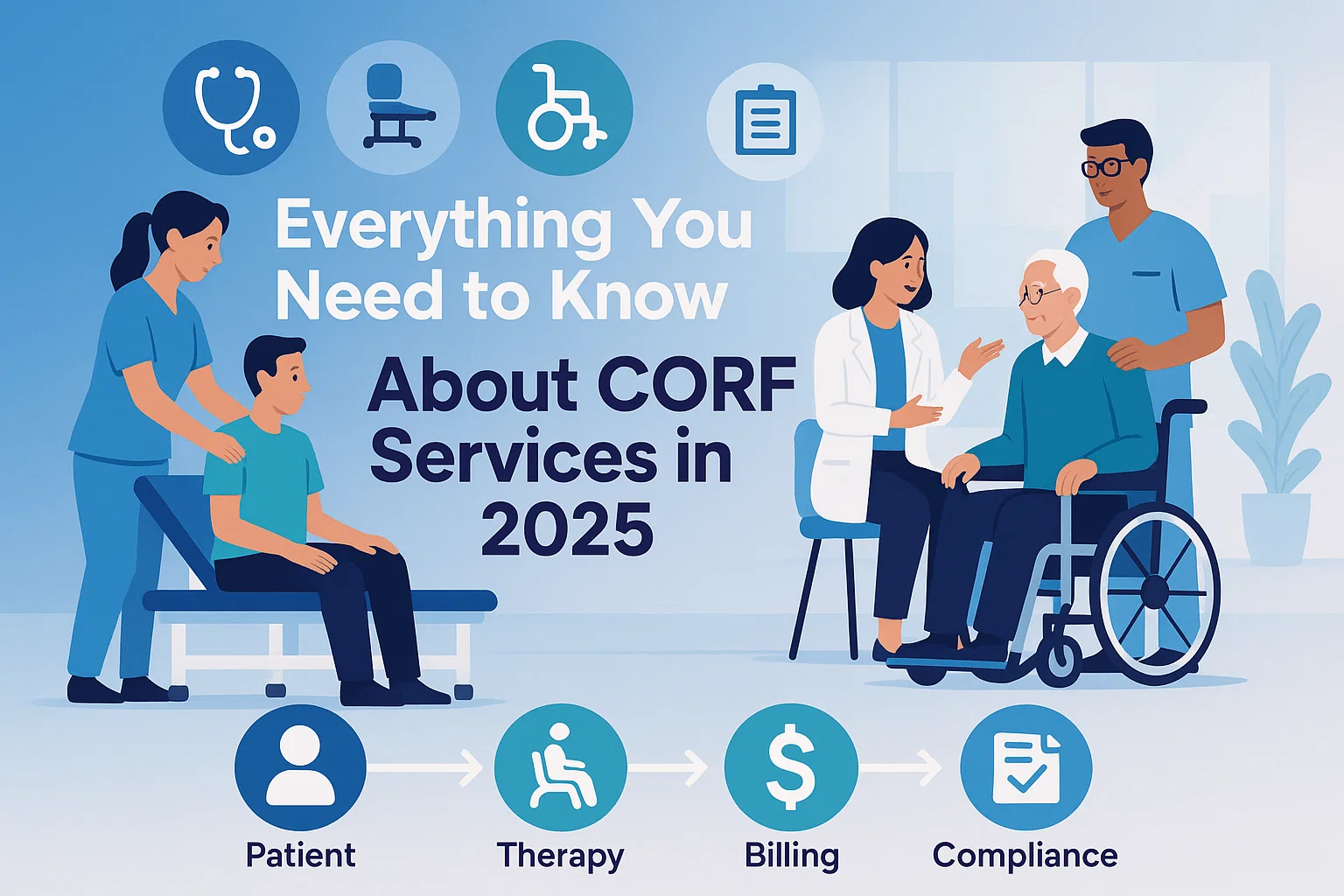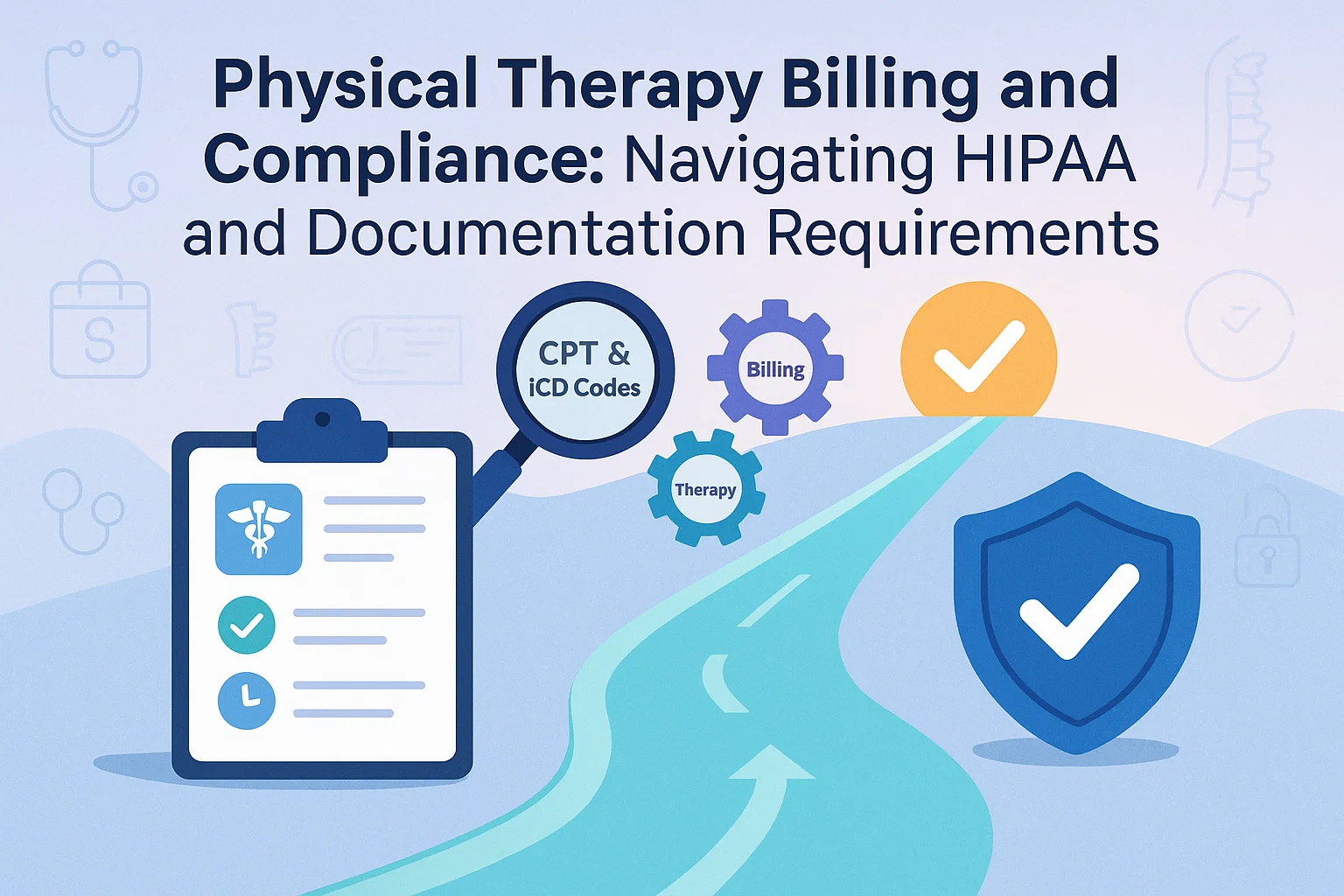1. Introduction
If you’re a healthcare provider, physical therapist, or clinic manager, you’ve probably heard about CORF Services — but you may still wonder how they really work in 2025.
Let’s make it simple. A CORF, or Comprehensive Outpatient Rehabilitation Facility, is a healthcare setup where patients receive rehabilitation services without being admitted to a hospital. Think of it as a one-stop outpatient rehab center — where patients can access physical therapy, occupational therapy, speech therapy, and social support all under one roof.
These facilities play a massive role in today’s healthcare landscape, especially after the pandemic. With hospitals overloaded and inpatient care costs rising, CORFs offer affordable, accessible recovery for patients who need consistent therapy.
In this complete guide, we’ll explore what CORF Services are, how to get certified, how billing works, and what’s new in 2025. By the end, you’ll clearly understand how to manage a CORF facility efficiently, stay compliant, and keep your reimbursements flowing smoothly.
2. What Are CORF Services?
At its core, CORF Services are all about helping patients recover faster and live healthier lives — without needing hospital stays. These facilities focus on patients who need rehabilitation after illness, injury, or surgery but can safely continue treatment as outpatients.
A Comprehensive Outpatient Rehabilitation Facility typically offers:
- Physical Therapy: For pain management, muscle strengthening, and mobility improvement.
- Occupational Therapy Services: Helping patients regain the ability to perform daily living tasks.
- Speech Therapy: Assisting those who struggle with communication or swallowing after a stroke or trauma.
- Social and Psychological Support: Addressing the emotional side of recovery.
Now, let’s clear up a common confusion: CORF vs. ORF (Outpatient Rehabilitation Facility).
| Feature | CORF | ORF |
| Services | Multi-disciplinary (PT, OT, Speech, Social) | Focused on specific therapy types |
| Physician Supervision | Required | Optional in some cases |
| Medicare Certification | Mandatory | Optional |
| Patient Focus | Complex rehab needs | Routine outpatient therapy |
By outsourcing your CORF billing services, you can focus on patient care instead of chasing reimbursements.
3. Why CORF Services Matter in 2025
The healthcare industry is shifting fast, and CORF Services are more relevant than ever.
After COVID-19, the demand for outpatient rehabilitation skyrocketed. Patients now prefer care that’s flexible, affordable, and accessible from home or nearby clinics. CORFs bridge that gap perfectly.
Here’s what’s driving the growth in 2025:
- Increased aging population: More people need rehab after orthopedic surgeries or chronic illnesses.
- Cost efficiency: CORFs lower the cost of inpatient stays.
- Technological innovation: From telehealth to digital documentation, CORFs are going digital.
A recent industry report suggests that the outpatient rehab sector is expected to grow by over 6% annually through 2025. That means more opportunities — but also more compliance challenges.
For providers, this is the time to streamline operations, strengthen billing, and stay updated with Understanding Medicare Billing for Physical Therapy: Rules, Updates & Compliance to ensure every service gets properly reimbursed.
4. Key Components of a CORF Facility
To run a successful Comprehensive Outpatient Rehabilitation Facility, you need a balance of skilled professionals, proper infrastructure, and compliant processes.
Let’s break down the main service areas:
Physical Therapy
This is the backbone of most CORFs. Physical therapists help patients restore mobility, reduce pain, and regain independence after surgeries, fractures, or chronic conditions.
Efficient physical therapy billing services ensure you’re reimbursed correctly for each session while maintaining compliance.
Occupational Therapy Services
These services focus on helping patients perform daily tasks — dressing, cooking, or working — after illness or injury. The Role of OT Billing Units in Occupational Therapy Billing becomes vital here, as accurate coding determines how your clinic gets paid.
Speech-Language Pathology
Speech therapists address communication disorders and swallowing difficulties. These treatments often require multiple visits, so accurate billing and documentation are key.
Social and Psychological Support
Patients often face emotional struggles during recovery. CORFs that include social and counseling services can provide more holistic care and improve long-term outcomes.
➡️ How CORF Services Promote Holistic Patient Care:
By combining therapy, counseling, and medical supervision, CORFs deliver complete, patient-centered recovery — physically and emotionally.
5. Licensing and Medicare Certification Requirements
Setting up a Comprehensive Outpatient Rehabilitation Facility isn’t as simple as renting space and hiring therapists. To qualify as a CORF under 42 CFR Part 485, Subpart B, you need to meet specific Medicare certification and state licensing requirements.
Here’s a simple breakdown:
Medicare Certification Requirements
- The facility must offer physician-supervised services.
- A plan of care must be established and certified by a doctor.
- Services must meet Medicare coverage criteria and be medically necessary.
- The CORF must comply with all safety, staffing, and patient care regulations.
State Licensure
Each state has unique rules for rehab facilities. You’ll need appropriate permits, licensed practitioners, and compliance with building safety standards.
Quick CORF Setup Checklist
✅ Medicare enrollment completed.
✅ State license obtained.
✅ Physician-certified plan of care process in place.
✅ HIPAA-compliant record system.
✅ Staff trained on billing codes and updates.
Failing to follow these steps could result in delays or reimbursement denials. So, before you open your doors, make sure your foundation is rock solid.
6. CORF Billing and Reimbursement Process
Here’s where things get interesting — and sometimes confusing.
Billing for CORF Services follows strict Medicare guidelines. Each treatment, test, and visit must be coded, documented, and submitted correctly. Even one small mistake can delay payment or trigger an audit.
Let’s simplify it.
Step-by-Step CORF Billing Process:
- Patient Evaluation: Start with a physician-certified plan of care.
- Assign CPT Codes: Each therapy session uses specific billing codes.
- Apply Modifiers: These indicate therapy type or duration.
- Calculate Billing Units: Follow The Role of OT Billing Units in Occupational Therapy Billing to determine how time-based services are billed.
- Submit Claims: Send to Medicare or private insurers electronically.
- Track Payments: Review EOBs (Explanation of Benefits) for accuracy.
Errors like missing documentation, incorrect signatures, or overlapping units are common. Partnering with professionals who specialize in physical therapy billing services can save you time and prevent costly denials.
7. Common Compliance and Audit Challenges
Even well-run facilities face compliance issues. In 2025, CMS is tightening its audit processes for all outpatient services — including CORFs.
Here are the most frequent challenges:
- Incomplete documentation of therapy time or services.
- Expired physician certifications leading to claim denials.
- Inaccurate billing units in therapy records.
- Failure to meet Medicare coverage criteria.
To stay ahead, regularly train your team, update your billing software, and stay informed about Understanding Medicare Billing for Physical Therapy: Rules, Updates & Compliance changes.
Remember, compliance isn’t just paperwork — it’s what protects your revenue.
8. Best Practices for Managing CORF Operations
Managing a Comprehensive Outpatient Rehabilitation Facility successfully means balancing quality care and accurate billing.
Here are five habits of high-performing CORFs:
- Embrace Technology: Use integrated EHR systems that sync with billing software.
- Invest in Staff Training: Regular updates on CPT codes and billing regulations.
- Focus on Patient Outcomes: Happy patients = better reviews and reimbursements.
- Maintain Compliance Documentation: Always ready for audits.
- Collaborate with Experts: Outsource physical therapy billing services or RCM support for efficiency.
A well-organized CORF doesn’t just meet regulations — it thrives because of them. When you build systems that support both care and compliance, you set your facility up for long-term success.
9. 2025 Updates: What’s New for CORFs
Healthcare regulations never stand still. In 2025, CORF Services are adapting to new changes in billing, compliance, and patient care models.
Here’s what’s new:
- Expanded Telehealth Coverage: Medicare continues to support remote therapy sessions, especially for rural areas.
- Updated Billing Thresholds: Therapy caps are now more flexible, reducing claim rejections.
- Digital Health Focus: HIPAA compliance now includes data security audits for digital tools.
- AI in Documentation: Many CORFs are adopting AI-based note systems to simplify billing and patient tracking.
Keeping up with these trends helps your facility stay compliant and competitive. It’s also a good time to revisit your partnership with physical therapy billing services providers — they often update software and procedures to match CMS rule changes.
10. Conclusion
As we step deeper into 2025, the role of CORF Services in the healthcare ecosystem is stronger than ever. These facilities bridge the gap between hospitals and home care, offering affordable, personalized rehab for patients who need it most.
From understanding Medicare rules to managing compliance and billing, every step counts. Whether you’re launching a new Comprehensive Outpatient Rehabilitation Facility or improving your current one, focusing on efficiency, technology, and accuracy will help you grow sustainably.
So, as you manage your facility this year, remember:
Stay compliant, stay updated, and don’t hesitate to rely on trusted partners for physical therapy billing services and expert insight into The Role of OT Billing Units in Occupational Therapy Billing — because when your billing is accurate, your care can truly shine.











